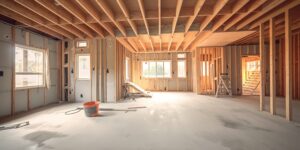Following a historic 2022 in residential construction, PWSC assembled Five Homebuilder Trends for 2023 to kick off the new year. Now with 2024 just a few months away, it’s a good time to see how those predictions panned out.
Turns out we’re pretty good at spotting future trends, but some things still surprised us. Here’s a look at where things stand now as we start planning for what 2024 has in store.
Trend #1: The (Not-So) Great Rebalance in Housing
Though many consider “location, location, location” the first rule of real estate, we expected “price, price, price” to be the biggest driver in 2023. Home prices hit all-time highs in 2022 keeping many out of the market. We predicted a slight rebalancing between home inventory, inflation, prices, and interest rates. What goes up must come down, right?
The market has experienced a correction, but as expected, price and inventory remain major problems.
Mortgage rates have builders and buyers wary. Interest currently sits above 7%, with four rate hikes already in 2023. The first quarter of 2023 saw the lowest number of mortgage originations since the second quarter of 2014. On a positive note, inflation declined to 3.2% from 6.5% in 2022. However, the Fed is shooting for 2% and has put everyone on notice that additional rate increases are likely before year end.
Despite what economists debate is a modest housing recession, prices remain high. That is contrary to what usually happens. The culprit is inventory, which was tight in 2022 and has gotten worse, decreasing 14% from a year ago. As a result, the median home price is only down by about 5.5% to $416,000.
But there is a bright side to this for builders—new home sales. As a percentage of total sales, new homes now comprise 30%, up from the norm of 10-20%. The premium for a median-priced new home versus an existing house is just $5,000 making new construction an attractive option.
As a result, builder confidence is coming back. The NAHB/Wells Fargo Housing Index (HMI) fell to 31 in December 2022, which was the lowest confidence in a decade. The number is back up to 56 for the third quarter of 2023. Anything above 50 indicates favorable conditions for new home sales.
So, while the market may not have rebalanced all that much in 2023, the scales favor builders.
Trend #2: Builder Sales Teams for the Save
High mortgage rates and low home inventory have created a “lock-in effect.” Existing homeowners are unwilling to sell and give up their low interest rate. That has potential buyers gravitating toward new construction, but builders are relying on incentives to seal the deal—just as we predicted.
According to the National Association of Home Builders, 55% of builders are using incentives to bolster sales. That is up about 15% from the prior year. Common incentives include price reductions and extra perks like free home upgrades.
Mortgage rate buy-downs are the most popular option currently. According to Devyn Bachman, senior vice president of research and operations at John Burns Research and Consulting, total incentives as a percentage of sales price would hover around 1-2% in a normal market. Right now, the rate is about 4% nationally.
Teams would rather cut into their margin than lose a sale. Builders across the country indicate that the best strategy for selling a home among current market conditions is making it more affordable by tackling interest rates directly.
Trend #3: Merger and Acquisition Momentum
We anticipated that the 2023 housing market would create significant stress for builders of all sizes. That comes in the form of meeting shareholder growth expectations for public and foreign companies. For private builders, the tension is financial from the cost of land, construction materials, and borrowing rates. The vice-like pressure coming from both sides primed 2023 for mergers and acquisitions.
According to Tony Avila, CEO of Builder Advisor Group, generating a tremendous amount of cash is the goal for stronger homebuilders in 2023. They want to deploy that capital by buying time-tested operators who already own land parcels, have established relationships, boast a strong reputation, and have the desire to grow.
This may be good news for smaller, or more regional builders, spooked by recent bank closures that have dried up some lending channels. Wanting to take advantage of the strong demand for housing, these builders have projects earmarked and just need capital to buy the land or launch the project. That makes the perfect opportunity for a merger or acquisition to benefit both sides. We expect to see strong M&A activity for the remainder of 2023 and into 2024.
Trend #4: Renovating the Buying Experience
Perhaps the strong demand for new construction has kept builders from focusing on the buying experience as much as they’d like in 2023. We’ve seen advances in this area, but there is still room for improvement. The need to renovate how homes are sold is growing more important.
According to the National Association of Realtors, 95% of homebuyers use the internet during their home search. Just over half found the property they eventually purchased online. Yet the digital homebuying experience still lags other industries selling big ticket items. Consider shopping for a car online, where even smaller dealers are offering an interactive experience. While big builders have made impressive strides in bringing tech to the home buying experience in 2023, there is a long way to go before this becomes status quo for builders of all sizes.
Buyers increasingly want visuals, details, and personalization. They want to envision themselves in the home and have touches that make it their own. Digital is the best way to do that. The builders who do this well will have a distinct competitive advantage in both up and down markets.
Trend #5: “Let’s Just Rent”
Subpar conditions for would-be homebuyers have been optimal for boosting the build-to-rent (BTR) sector. As anticipated, the market has continued to grow in 2023. BTR homes now comprise 7% of new construction starts, up from just 3% in recent years.
BTR occupancy currently sits at 97% with people clamoring for more inventory. More and more people see single-family rentals as the new starter home. They are popular among seniors and younger families alike.
The steady demand now has at least 12 of the top 50 U.S. builders reporting build-to-rent homes in their closing numbers. Lennar leads the way with more than 2,400 rental homes constructed.
The biggest challenge to BTR’s growth trajectory is the high cost of borrowing. Bruce McNeilage, CEO of Kinlock Partners, owner of four build-to-rent communities, said expansion is the goal, but the cost of money is the problem. That leaves operators stuck with their current inventory or raising the rent.
Luckily, institutional investors still see the tremendous upside of BTR. They view the investment as safe and have the capital earmarked to jet propel significant growth in the single-family rental market in the years to come.
Plan for the Future with PWSC
When it comes to predicting the future, PWSC does it pretty well. By staying ahead of what’s happening, we can develop unique insurance and warranty solutions that address an ever-evolving industry. In fact, PWSC stands as the first company offering BTR and SFR warranties in addition to best-in-class homebuilder warranties. Learn more about our services and stay tuned as we formalize our predictions for 2024.




